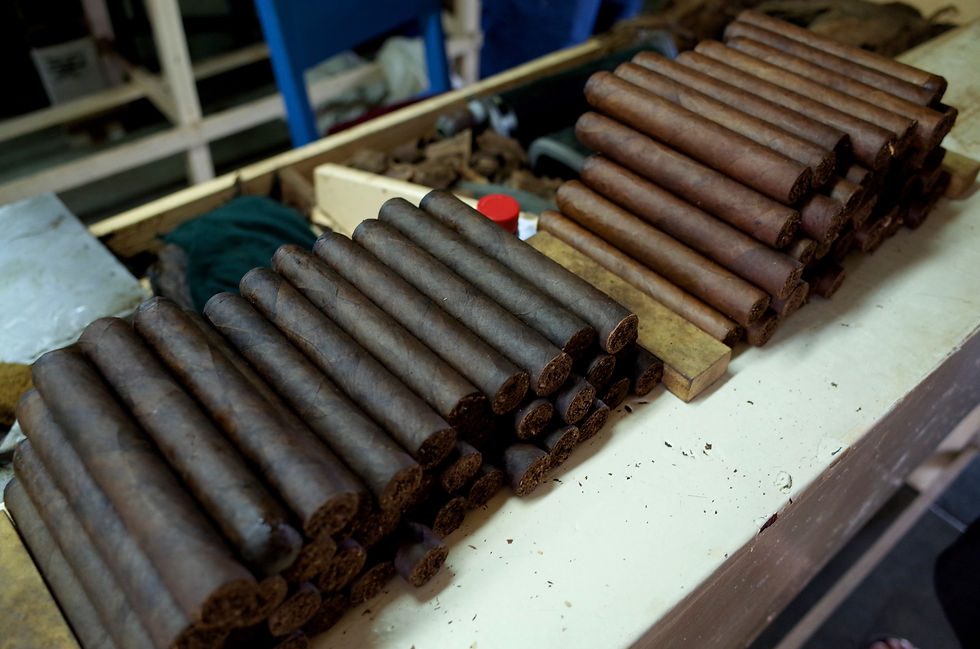The Rich Heritage of Tobacco from Nicaragua
- Gareth Pearce

- Aug 16
- 4 min read
Updated: Aug 20

Nicaragua, a country acclaimed not just for its breathtaking landscapes but also for its vibrant and colourful culture, stands out on the global stage for its exceptional tobacco. The tobacco industry here has thrived over the years, particularly in the domain of premium cigars, establishing Nicaragua as a formidable contender in the international market. This blog post explores the distinctive characteristics of Nicaraguan tobacco, the rich regions where it is cultivated, and the artistry that underpins its cigars.
The Tobacco Growing Regions of Nicaragua
Nicaragua's landscape is home to several exceptional tobacco-growing regions, each imparting unique flavours and characteristics to the tobacco produced. The most notable regions include:

Estelí
Often heralded as the epicentre of Nicaraguan tobacco production, Estelí boasts volcanic soil that, along with an ideal climate, cultivates robust tobacco. The leaves from this region are famed for their strength and bold flavour, making them a favourite among cigar enthusiasts. The rich, earthy notes present in Estelí tobacco are frequently described as full-bodied, delivering a profoundly satisfying smoke that is sure to please.
Condega
Situated a mere stone's throw from Estelí is Condega, another key player in Nicaragua’s tobacco landscape. Tobacco from this region is typically medium-bodied, offering a delightful interplay of sweetness and spice. Smokers often note the presence of cinnamon and other subtle flavour nuances, making Condega tobacco an adaptable choice for blending. The region's unique terroir enriches the complexity of its tobacco, which is highly sought after for numerous premium cigars.
Jalapa
Towards the north, the Jalapa region is renowned for its more delicate and nuanced tobacco. The cooler climate and elevated terrain of Jalapa yield leaves that are predominantly used for filler in premium cigars. The tobacco from this area is highly prized for its intricate flavours, which may include floral and herbal notes that present a delightful contrast to the bolder tobaccos hailing from Estelí and Condega.
The Unique Flavour Profile of Nicaraguan Tobacco

What distinctly sets Nicaraguan tobacco apart from its global competitors is the remarkable flavour profile inspired by the region’s volcanic soil. This rich and mineral-laden earth contributes to the bold, earthy essence characteristic of Nicaraguan cigars. Smokers can anticipate a multifaceted experience, filled with layers of flavour that evolve with every puff.
Nicaraguan cigars are often noted for their rich, full-bodied nature, where strong earthy tones elegantly intertwine with hints of sweetness and spice. This intricate complexity appeals to novices exploring the world of cigars as well as seasoned connoisseurs seeking a masterfully crafted smoking experience.
Conclusion

Nicaraguan tobacco is a treasure trove of flavour and cultural significance, deeply embedded in the nation's history and traditions. The diverse growing regions and unwavering commitment to excellence have positioned Nicaragua as a leader in the global cigar market. Whether you are an experienced aficionado or a curious newcomer, delving into the world of Nicaraguan tobacco invites you on a journey filled with rich flavours and artisanal craftsmanship that is truly unparalleled.
As you prepare to light up a Nicaraguan cigar, take a moment to reflect on the dedication and artistry embedded in each leaf, and savour the distinctive experience that only Nicaraguan tobacco can offer.
Pairing Notes

Nicaraguan Cigars with Port Wine or Dark Chocolate:
The robust and complex flavours of many Nicaraguan cigars harmoniously blend with the rich sweetness of port wine or the intense bitterness of dark chocolate. This pairing enhances the smoothness of the smoke, creating a delightful contrast and allowing the flavours of both the cigar and the accompaniment to shine.
Cigars with Steak:
For cigars such as Punch Punch Tubos or Bolivar Royal Corona, nothing beats a well-cooked steak. The savoury and hearty richness of grilled meats complements the deep flavours of these robust cigars, resulting in a satisfying culinary experience that tantalises the palate.
Medium-bodied Cigars:
When enjoying medium-bodied Nicaraguan cigars, consider pairing them with smooth bourbons like Angel's Envy or Basil Hayden. The sweet and caramel notes of bourbon accentuate the cigar's flavour profile, adding depth and complexity while enhancing the overall enjoyment.
Darker Liquor Cocktails:
Full-bodied Nicaraguan cigars find their perfect match in darker liquor-based cocktails, such as an Old Fashioned or a Manhattan. The richness and complexity of these cocktails complement the boldness of the cigars, elevating the overall tasting experience to new heights.
Espresso or Dark Roasts:
For a truly robust flavour journey, pairing full-bodied cigars—particularly Maduro blends or Nicaraguan Puro—with dark roasts or freshly brewed espresso is the way to go. The deep, intricate flavours of the coffee merge beautifully with the cigar, delivering a hearty and satisfying combination.
Spicy Cigars with Rye Whiskey:
If you have a penchant for spicy cigars, consider teaming them up with rye whiskey. The bold, peppery notes of rye provide a wonderful contrast to the cigar's spice, creating a balanced and dynamically flavourful pairing sure to please adventurous palates.
Mild Cigars with Gin or Vermouth:
For milder cigars that exhibit citrus or floral notes, a refreshing combination with gin, Campari, or vermouth comes highly recommended. The botanical and crisp qualities of these spirits elevate the cigar's subtleties, providing a light and refreshing experience that’s perfect for sunny afternoons.
These thoughtfully curated pairings can significantly enhance your enjoyment of Nicaraguan tobaccos, resulting in a delightful smoking experience that engages all the senses. Whether you're with friends or enjoying a quiet moment to yourself, these combinations will surely delight and tantalise your taste buds.



Comments